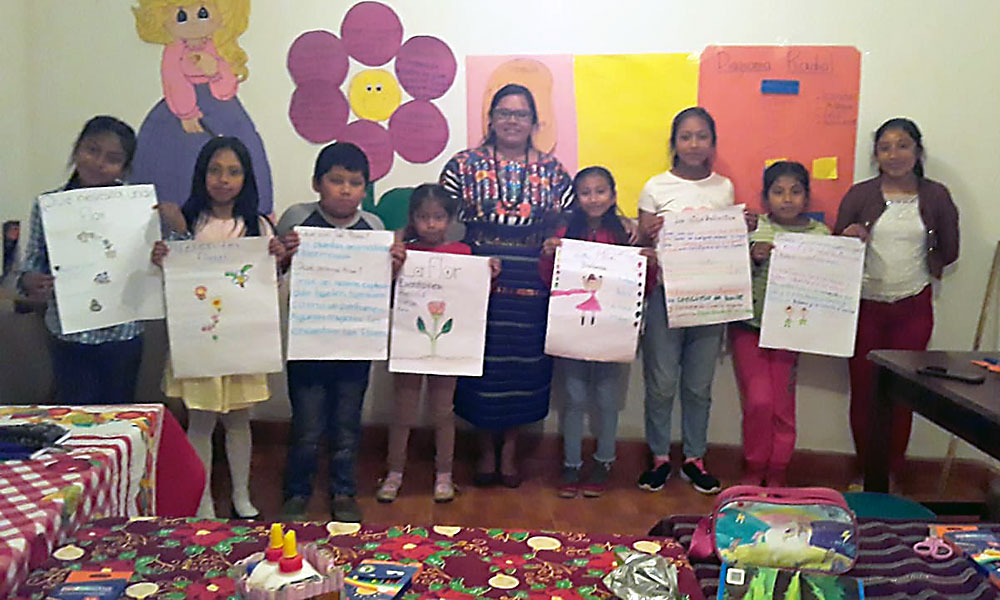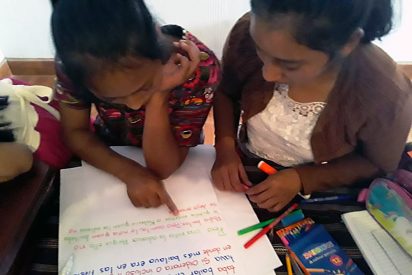
One corner of teacher Gloria Cocon Sir’s home is covered with colorful word walls, story maps and writing samples. There are tables scattered with plenty of poster paper, glue and colored pencils and kids who are busily working on giant books.
In normal times, Gloria is a kindergarten teacher at the Xetzitzi school in Patzun. But these days she presides over a stay-at-home classroom of nine kids, ranging in age from 6 to 15.
“My Child Aid trainer, Maria de Los Angeles, encouraged me to practice what I had learned in the training workshop,” she says. So I decided to practice with my nieces and nephews in my family.”
Schools in Guatemala may be closed due to the Covid-19 Pandemic, but the learning hasn’t stopped for teachers in Child Aid’s training program. Our trainers are staying in touch and providing whatever kinds of coaching and support teachers need. Teachers can ask lingering questions about techniques they learned in their last workshop, request additional examples, or get help with lesson planning.
Practicing at Home
The best way for teachers to learn new techniques is to use them with their students. But teachers can’t practice when they don’t have a class work with. So many teachers like Gloria are finding ways to keep teaching and learning by working with the kids who are most close at hand these days — their own children or members of their extended families.

In their makeshift classroom, Gloria and her nieces and nephews work together on activities. They read, play games, sing songs and work on multiplication tables. Recently, the kids worked on a writing project, creating and illustrating their own stories. “I want them to use their creativity, drawing and teamwork skills,” says Gloria.
“I was so excited to go and teach the new ideas to my students, but I was never able to because of the situation we’re in now,” she says, referring to the necessary nationwide school shutdown. “I miss spending time with my students, reading with them, singing, and teaching them new things.”
One of Child Aid’s greatest organizational strengths is the strong relationships and trust our trainers develop with teachers through many hours of workshops and on-on-one coaching. During this time of uncertainty, when our normal face-to-face interactions are impossible, those relationships remain strong and are vital to continuing our work supporting teachers — even at a distance.
What does “Distance Training” look like?
Here are some concrete ways Child Aid Literacy Trainers are working in their communities:
Online Coaching – Trainers are working one-on-one with teachers via phone or video conferencing. It’s an opportunity to answer questions and discuss ideas for connecting with students during the shutdown. After his session with trainer Meliza Chacon, teacher Hugo Huitz was inspired to find ways to promote reading in his community of Patachaj. He shared books with his students and showed them how to read aloud with each other at home and ask questions about the reading.
Video Training. When teachers want to see another example of a teaching technique they can request a video. Trainers will record videos of themselves explaining or demonstrating the technique and share it with teachers via the WhatsApp platform.
Virtual Book Club. Literacy Trainer Angie Barreno hosts an online book club each month with six teachers from the Sacmixit school. The educators each read a novel of their choice and share with the other members: It’s a great way for teachers to build their own reading skills and have a better understanding of how to run a book club with their own students.
Lesson Planning Together. Literacy Trainer Paola Aju Coy is working with teachers at the El Sitio school to develop reading lessons that kids do at home along with instructions for parents on how to work with their kids.
Through these virtual connections, teachers have stayed active and engaged in improving their teaching skills and continuing to prepare for the day when they can leave their homes and return to their classrooms.